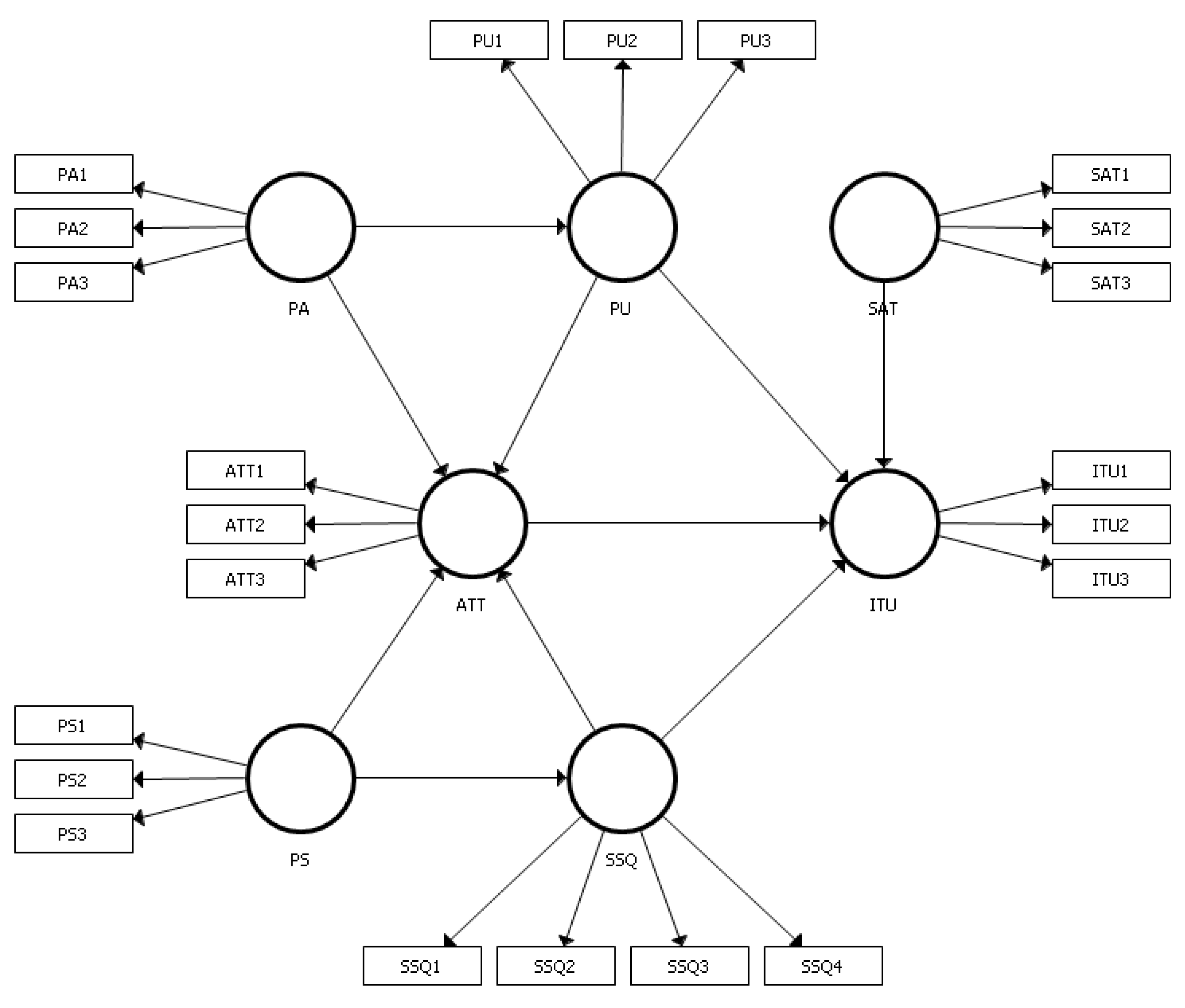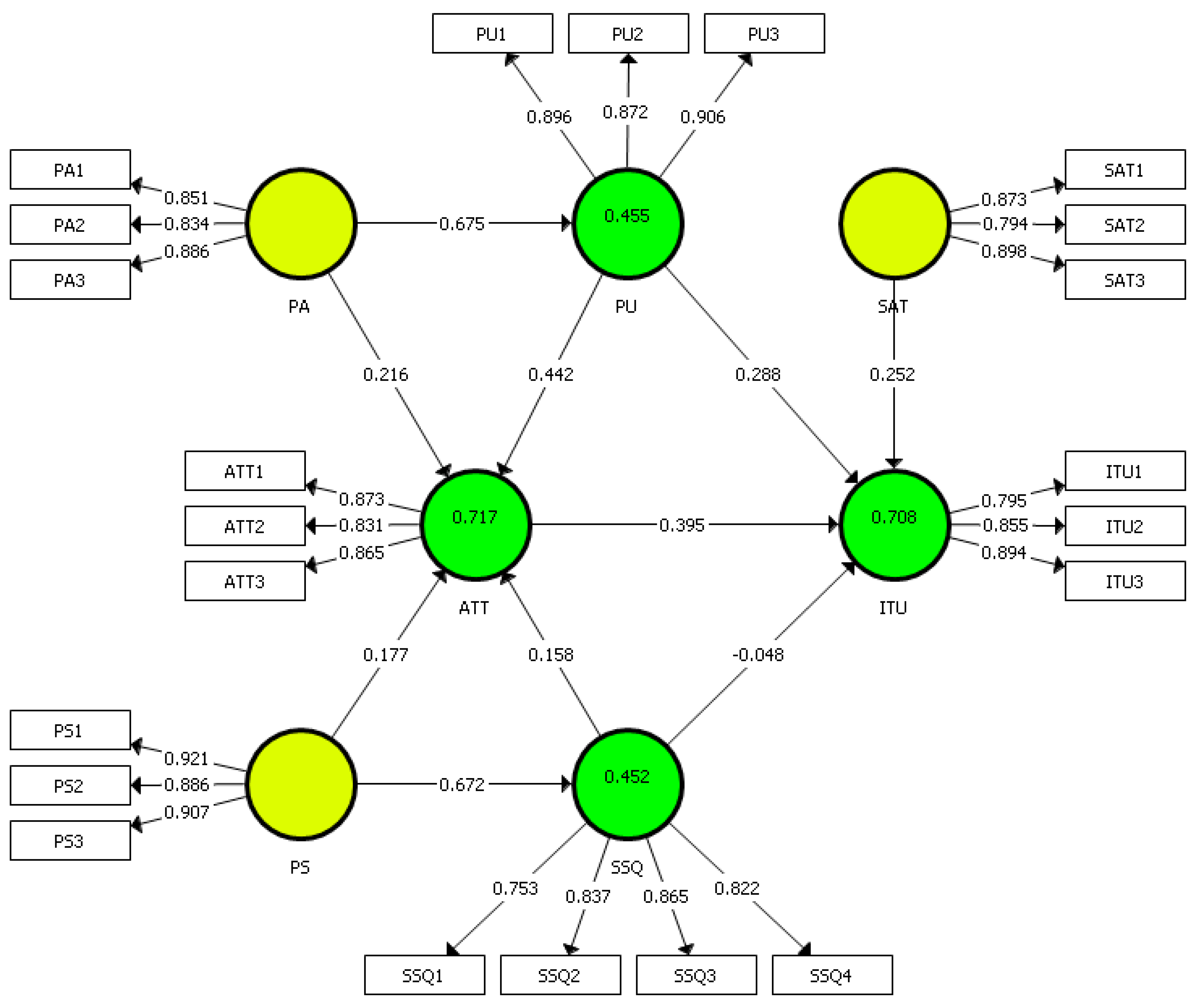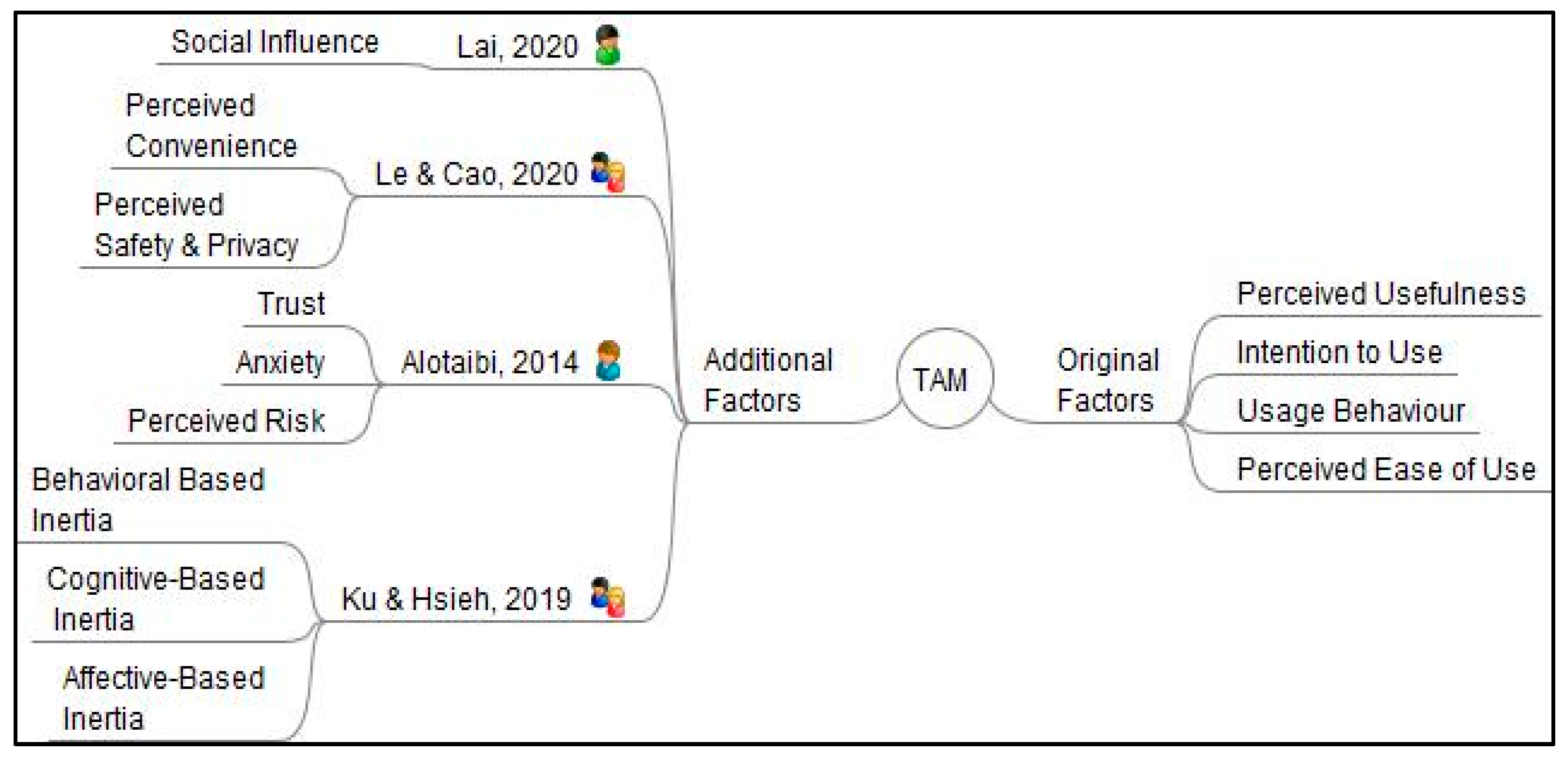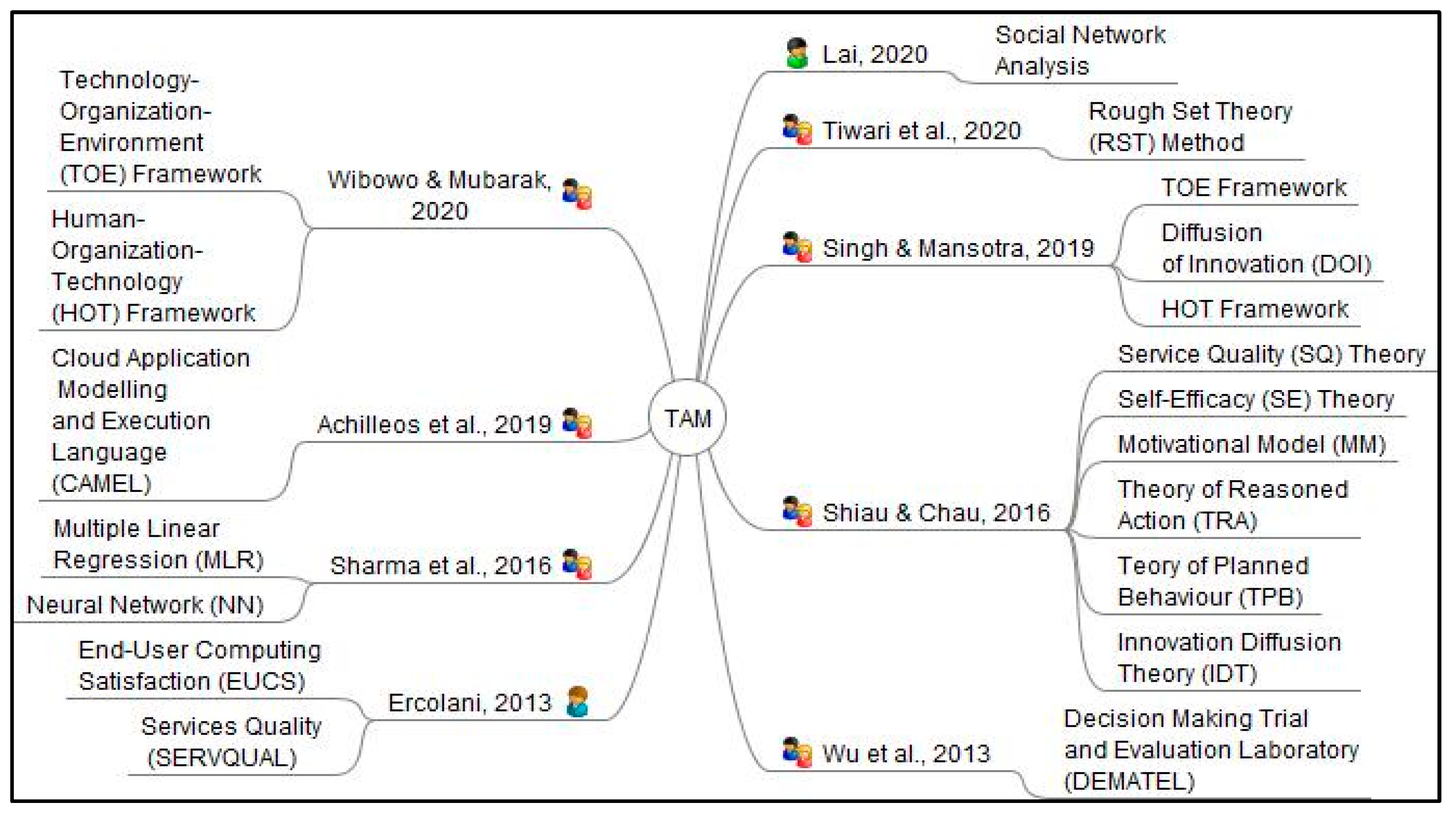2.1. The Motivation of TAM Application for Cloud Computing (CC) Adoption Evaluation
Nowadays, the Internet is emerging as the cheapest global communication infrastructure. It is argued to be the largest digital information highway and digital library. The flexibility of searching, easiness of access to digital products, and volume of data bring reduction of paper usage. The Internet is considered as an open and inexpensive platform for personal and professional applying, as well as a social environment supporting connectivity, integration, cooperation, and collaboration of business units [
4]. Cloud computing (CC) is one among a number of concepts resulting from information communication technology (ICT) and in particular from the Internet development. CC is an ICT service distribution paradigm that included delivering hosted services over the Internet, based on a pay-as-you-go approach. It provides radical changes in business processes in organizations. The decision to implement CC solution has many reasons:
Reduction in costs associated with delivering ICT services, reducing costs of hardware and software, and in general reduction of the total cost of ownership;
Economics of scale;
Reduction in management responsibilities for ICT services and resources;
Increase of business agility and scalability to meet the needs of rapidly changing business environment;
Control and optimization of resource allocation;
Application of metrics to determine the usage for billing purposes, monitoring, controlling, and reporting;
Providing measures for disaster recovery and business continuity.
The CC adoption strategy requires a change of thinking about ICT and considering it as a service recognition and adoption process [
5]. The service-centered view of ICT stipulates recognition of customer capabilities and expected by them benefits, development of service-oriented competencies, knowledge, skills, and involvement of customers in value delivering process, and monitoring service outcomes to improve customer collaboration. Doug Thomson [
6] suggests that a cloud strategy emphasizes three specific characteristics, i.e., awareness, experience, and value. The CC awareness aims to generate recognition that particular service providers have an appropriate cloud-computing offer. Therefore, they organize advertising and marketing campaigns aimed at a potential customer’s decision makers. The experience characteristics of CC market should invite client organizations to experience cloud technology and to understand the technology, security, scalability, and skilled expert staff in action. The value characteristics should establish relationships among customers and ICT vendors, understand the business requirements, and demonstrate market leading capability in a way that is targeted to meet the business organization’s needs. The value of ICT concerns two fundamental questions, i.e., sustainability in ICT and sustainability by ICT [
7].
In general, sustainable development is the practice of meeting the needs of society today without compromising the ability of future generation to meet their own needs. The term “sustainability,” in its environmental usage, refers to the potential longevity of vital human ecological support systems, such as the planet’s climatic system, agriculture systems, industry, and human communities in general and the various systems on which they depend. Models of governance for sustainability need to concentrate more on change than stability, meaning that existing rules, customs, practices, and rights are seen more as the subject matter of governance to be influenced, than as the main business of governance. The challenges of governance for sustainability lie in four broad and changeable areas, i.e., innovation, reconciliation, creativity, and adaptability [
8]. Understanding sustainability requires the simultaneous effort of balancing economic, social, and environmental goals for a business unit. As such, sustainability is a metaphor for describing social responsibility, corporate citizenship, and ethical business conduct. CC implementation projects include also sustainability issues consideration. The ICT project sponsors are to be interested in the potential impact of the proposed work and project results’ dissemination adequacy to ensure optimal use of the project results, means and methods to strengthen technology, effective planning, and exploitation of results and dissemination of knowledge within and outside the project community. Questions to be considered are following:
What is the potential strategic impact of the proposed CC implementation action?
Does the proposal identify a community that will benefit from the results?
Do the user organizations commit to further use, if the user experience is gained?
Sustainability can also be interpreted as the continuation of the benefits provision after assistance from a donor has been completed [
9]. The focus is on sustaining the flow of benefits in the future. Therefore, managing sustainability is a process aimed at maximizing the flow of sustainable benefits. It is a process that must be monitored, reviewed, and updated as circumstances change and new lessons are learnt from experience. Hilty and Aebischer [
7] explains that sustainability in ICT is making information and communication technology themselves more durable and eco-friendly. People need to consider the environmental impact of software, semiconductors, end-user devices, servers, data centers, and the global Internet as a whole, examining the footprint of ongoing operations, as well as the material life cycles. Sustainability by ICT is using technology to encourage sustainable practices in society as a whole. So, the ICT is expected to change supply chain management, the smart cities and green urban design, and reshape household energy consumptions patterns.
Cloud computing is considered as a practice of designing, manufacturing, using, and disposing of computers, servers, and associated systems efficiently and effectively with minimal impact on the environment [
10]. CC opens the door to a world of ICT service-orientation, but the services are expected to be designed for environment sustainability and energy efficiency. Therefore, providers of CC products and services focus on causal relationships between software and hardware:
Power consumption: How much power consumption by the hardware does the software cause during its execution—not only in local end-user devices, but also in network components, servers, and other devices involved in the process?
Hardware load: How much of the available hardware capacity is used by the software product?
Hardware management: Can software influence the operating states of hardware, especially by using power-saving modes?
Useful life of hardware: Can software products influence on the decommissioning of hardware products?
User perception: What are the user’s perception and experiences with the CC service? Do users think that CC product is durable? What is the user’s perception of the ecological value of the CC products? Does the cloud computing have other hardware dependencies when upgraded? Are the cloud services equally serviceable and accessible to different users?
The essential advantage of CC is that it involves end users in the creation of innovative value proposition generation as well as in the process of reengineering of the contemporary solutions.
There are many papers on technology acceptance models and methods, e.g., Technology Acceptance Model (TAM) [
11], Technology Acceptance Model 2 (TAM2) [
12], the Unified Theory of Acceptance and Use of Technology (UTAUT) [
13], Diffusion of Innovations Model (DIM), or the Status Quo Bias (SQB) theory explanations. The SQB theory is to explain why individuals prefer to maintain their current status, situation, or technology rather than to switch to new actions [
14].
Status quo bias (SQB) attributed to loss aversion depends directly on the framing of gains and losses. Loss aversion was defined by Kahneman and Tversky (1984), who argue that individuals weigh losses heavier than gains in making decisions [
15]. The SQB theory is also consistent with cognitive misperception known as anchoring. Samuelson and Zeckhauser explain it and argue that, in a decision-making, the probabilistic forecasts lead to a particular decision. In repeatable decision process, continuance of status quo can be explained as a preference to justify commitments to a previous course of actions [
14].
TAM was an early framework that identified two factors determining the user’s decision to use the new technology: perceived usability and ease of use. Lee and Coughlin (2015) confirmed that TAM should include many factors, e.g., value, usability, affordability, accessibility, technical support, social support, emotion, independence, experience and confidence, and availability [
16]. TAM2, which is a certain extension of TAM, includes beyond measures typical for TAM (i.e., perceived usefulness, perceived ease of use, intention to use, and usage behavior), also the following measures: experience, voluntariness, subjective norm, image, job relevance, output quality, and result demonstrability [
12]. In comparison with TAM and TAM2, the TAM3 model is the next extension of considered variables. Therefore, additional factors that are expected to be included, are as follows: computer self-efficacy, perception of external control, computer anxiety, computer playfulness, perceived enjoyment, and objective usability [
17].
The UTAUT model is a management tool for assessment of the likelihood of success for new technology implementations. Therefore, managers can understand the drivers of acceptance to support proactive designing, adoption, and technology system usage [
18]. The DIM model emphasizes the importance of usability of product or service. This model is particularly applied to the case of the diffusion of new telecommunications technologies [
19].
Most technology acceptance models were developed for organizational and consumer electronics context. The systematic literature review (SLR) was done to reveal domain of TAM model applications. Therefore, research question was formulated as follows:
RQ1: Can the TAM model be applied for CC adoption evaluation?
The survey included publications in repository Scopus, published in 2009–2020. The searching strings covered the words “Technology Acceptance Model” AND “Cloud Computing”. Eventually, 124 publications were selected.
Table 1 includes twelve publications, which were cited by more than 50 readers. The TAM questionnaires’ recipients are presented in
Figure 1. Questions in the survey concern mainly acceptance of new ICT; however, none of researchers emphasized sustainability. There is still a chance to undertake research on users’ recognition of sustainable issues.
In the literature, the structural equation modeling (SEM) technique concerns many different phenomena (
Figure 2). Selection of measures depends on prespecified research goals and relations among variables (
Figure 3).
In our theoretical contribution, we advance previous studies in the following areas. Comparing to Le and Cao [
33], they used only five latent variables, and only four were validated after model measurement. They did not use external variables, and their sampling method was not executed to the specialist in the field but friends. Our model contains seven latent variables, and we directed our study to professionals in the cloud computing fields. We believe that this improvement will produce more reliable results. Similar applies to advancing previous work of Alotabibi [
34]. The author used external variables closely related to the TAM model and invited study participants from an unknown event. Our study advances it by using external variables closer related to cloud computing like usability, availability, service & system quality, and security. The work of Singh and Mansotra [
39] contains a very complex model of 32 hypotheses. Still, they did not provide any information on the data source, neither sample size nor sampling method. We have constructed a model that connects TAM concepts with CC in our work, and we simplify its understanding. We also rely on professionals in the field.
2.2. Cloud Computing
Cloud types allow different levels of service configuration at both hardware and software levels. They are characterized by different purposes, which makes them differently priced by suppliers. There are recognized CC types:
Infrastructure as a Service (IaaS);
Platform as a Service (PaaS), and
Software as a Service (SaaS) [
41].
Hosting types allow customers to choose the way they want to deliver the service, which is tailored to the existing IT infrastructure, subscription and maintenance costs, and company privacy policy. They directly affect data security, and the way calculations are performed, and data is stored. We differentiate between these hosting types:
private cloud.
public cloud,
hybrid cloud, and
social cloud [
42].
The characteristics of the cloud are the main element distinguishing cloud solutions from their offline counterparts as well as other network services.
On-demand access is about enabling the recipient to quickly and easily configure cloud resources, such as computing power, network, or disk space, at any time. The user does not need to know about the physical hardware [
43].
Scaling is possible with virtual machines (VM). As customer demand increases or the number of users increases, new resources are automatically allocated [
44]. When a user reduces the computing power requirement, resources are released and assigned to other users. The whole process is supervised by Hypervisor and load balancer software, which oversees and predicts the potential load on VMs.
Mobility is provided via the Internet. Users can access resources anytime and anywhere and from any device [
45]. It allows users to continue working on any device with Internet access.
Grouping of resources consists of combining resources to share and synchronize them automatically. Examples of resources that can be grouped are servers, virtual machines, disk space, networks, CPU units, and RAM [
46]. Synchronization allows multiple users to work together and access the most current versions of files.
Measurability of the service is ensured by constant monitoring of resource usage by users. Data is collected, reported, and made available to calculate the cost of the service [
47]. Information is provided to customers, which enables them to choose an appropriate service tailored to the current demand.
The advantages of the cloud are the main elements that determine its popularity. Computer software and licenses for many users can generate huge costs for the customer. Cloud computing is a much cheaper solution available in various subscriptions, prepayment, or one-time purchase models. Apart from that, the price of infrastructure development is lower and is fully supplied by the provider [
48]. The customers do not have to maintain IT departments that deal with maintaining the infrastructure.
Cloud makes hardware resources available immediately, without any additional investment from the user. It allows IT costs (hardware investments) to be converted into operating costs (cloud subscription). It makes it much easier for new companies without IT support to enter the market. Expansion of the hardware infrastructure is standardized to the extent that adding computing power is not a problem [
49]. Suppliers have ready-made packages in their offer, from which customers can build their solutions. The packages consist of various hardware and software configurations. Modules are added immediately, and it also generates lower costs than creating step-by-step configurations by selecting each component separately [
50]. This form of service extension is possible through virtualization.
Using the cloud, users can continue working regardless of place, time, or device. Broad access to data and the ability to work in co-operative mode significantly increases productivity [
51]. Cloud provides users with business continuity and data security during a failure. There is no problem with traditional server solutions, where expensive RAID arrays need to be configured to provide a copy of data [
52]. The entire process of installation, configuration, and upgrade of the system and the default applications is done on the vendor’s side, which provides customers with access to the latest solutions immediately, through a ready interface such as a web browser [
53].
Data security is a crucial component of all computer systems. In the case of the cloud, creating sufficient protection is a significant challenge for suppliers, as this technology combines most of the existing IT solutions. Cloud computing security is more complicated because it requires controlling the entire environment on two levels: physical and virtual machines. If a physical server is attacked, all virtual machines that use it will be compromised, and vice versa: an attacked virtual machine may infect the servers it uses. Providers prevent attacks by isolating instances of VMs from each other, introducing multi-stage user verification, and leaving administration and software issues to their clients [
54].
The main threats associated with the use of cloud computing are external attacks on infrastructure, spying on clients’ VMs by providers, and attacks between users, which include attacks on VMs and side-channel attacks [
55]. Infrastructure can be attacked through network nodes, after intercepting, in which an attacker can modify the query results displayed, carry out DoS attacks, or access sensitive user data [
56].
Clients perform operations on virtual machines, which means that many users use the same hardware. It creates the risk of data leakage or access to data by unauthorized persons [
57]. The calculations are performed in any place that currently has sufficient resources, which makes it significantly challenging to secure the performed calculations. For example, if a user decides to simulate a weather forecast, a significant increase in computing power demand will be detected, forcing the environment to allocate free resources with the fastest access time (within a purchased package), regardless of their physical location. It is complicated to find later the drives and processors that were involved in this calculation. Data stored in the cloud is defragmented across the entire disk space and has many unnecessary copies that are not needed to ensure data continuity. It makes it difficult to locate sensitive data in the cloud and secure it accordingly. Many environments hold data without proper encryption to speed up the services provided [
58].
The problem of cloud computing lies in its layered architecture, which is reflected in the presented cloud types. A cloud computing type consists of a combination of multiple layers of objects (virtual machines, APIs, services, and applications) where the functionality and security of higher layers depend on lower layers. The consequence of such an architecture is that the entire structure is exposed when a single object is compromised. It makes it difficult to manage security policies and access rights [
59]. Cloud computing is continuously evolving, with the risk of new security gaps.












